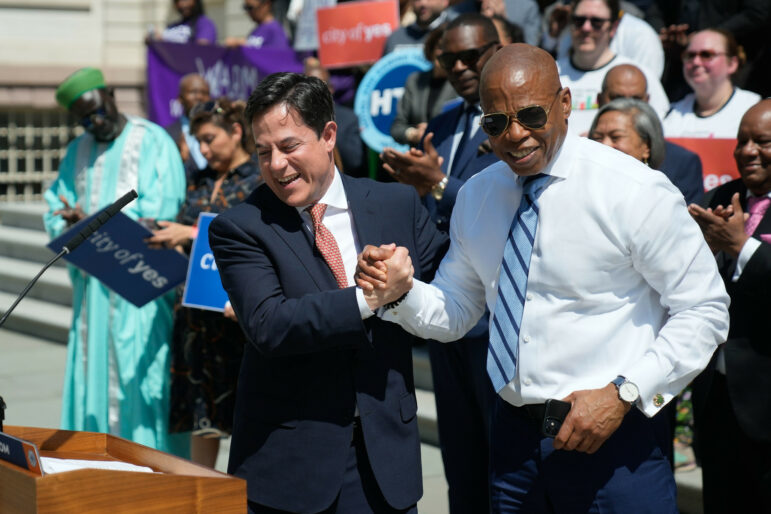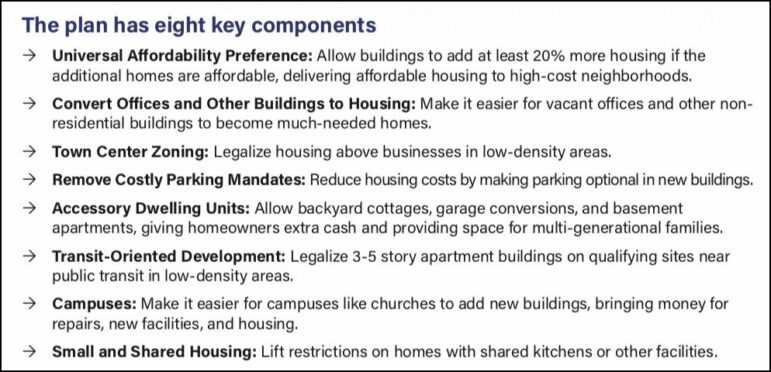As the mayor’s citywide zoning reform plan undergoes public review, City Limits is keeping tabs on responses. So far, more than half of the city’s community boards have voted unfavorably, though four out of five borough presidents have come out (largely) in favor.

Michael Appleton/Mayoral Photography Office
City Planning Director Dan Garodnick and Mayor Eric Adams at a rally in support of the housing plan in April.Mayor Eric Adams’ citywide zoning reform plan, the City of Yes for Housing Opportunity, continues to weave its way through the public review process before heading to a final vote in the City Council later this year.
The proposal is a key part of the Adams administration’s plans to address the city’s housing crisis by “making it possible to build a little more housing in every neighborhood,” through eight main changes outlined in the Department of City Planning graphic below.

Department of City Planning
So far, more than half of the city’s 59 community boards voted unfavorably on the plan, either outright or “with conditions”—meaning they might get on board if certain changes are made. Meanwhile, four out of the five borough presidents have come out in favor of the proposal (but with conditions they’d like to see met).
*An earlier version of this map incorrectly labeled the decisions for Manhattan CB5 and Brooklyn CB8. City Limits regrets the error.
The latest came from Queens BP Donovan, who shared his recommendations with the Queens Daily Eagle on Monday. While he's generally in favor of the proposal, Donovan called for various city agencies to examine the impact of new residential development on the borough's infrastructure, "such as school enrollment and classroom capacity, hospital bed availability, municipal service delivery and more." He also pushed for the plan to maintain parking mandates for new buildings in areas with fewer public transit options, like eastern and southeastern Queens.
The city's community boards have issued a mix of recommendations on the mayor's plan, with many neighborhoods in or closer to Manhattan coming out in favor, and opposition concentrated in lower density, outer borough districts.
"We believe implementing COY will make New York City environmentally sound, economically equitable, and more affordable," Brooklyn Community Board 6, which includes Park Slope, Gowanus, Carroll Gardens, Cobble Hill and Red Hook, wrote in a letter accompanying its "favorable" recommendation.
Boards opposed to the proposal have cited a bevvy of reasons: concerns about retaining current neighborhood character, the potential impact on existing infrastructure, allowing more as-of-right development without the need for community review, and calls for deeper affordability requirements among them.
Queens Community Board 3, which spans East Elmhurst, Jackson Heights and North Corona, wrote in its unfavorable resolution that it is "not against the development of affordable housing."
"We acknowledge the need for more affordable housing particularly within our district," Chairman Frank Taylor wrote, lamenting that most new construction in the area so far has been unaffordable. "While the proposal claims the development of new affordable housing there is no guarantee."
Under the city's land use review process, community board and borough president recommendations are only advisory—after they weigh in, the plan will go before the City Planning Commission and then the City Council, whose votes are binding.
Department of City Planning Director Dan Garodnick, who spearheaded the proposal, previously told City Limits that he and the agency "take community feedback seriously."
In his bid for the plan, Mayor Adams has urged the public to consider the city's record-high homeless shelter population—which sat at more than 146,000 people in June, the most recent month for which complete data is available—and last year's 1.41 percent rental vacancy rate, a historic low.
"Just about every place we go to talk about building housing like this, people give us a reason not to," Adams said during a press briefing Tuesday, when asked about opposition to another proposal to build affordable homes for seniors on city-owned land that's currently a community garden.
"I don't know how to get clearer to New Yorkers. People are homeless," the mayor said. "My responsibility is to place as many people as possible inside a home, because it feeds additional problems."
To reach the editor, contact Jeanmarie@citylimits.org
Want to republish this story? Find City Limits’ reprint policy here.









6 thoughts on “City of Yes for Housing: See How Your Community Board & Borough President Voted”
Reading the comments left by several of the community boards it’s clear they need to simply be abolished because they do not understand the needs of the city and are the reason why we are in this situation. New Yorkers want and need more affordable housing.
We need to build much more housing. We cannot only rely on years long processes for single developments or more limited neighborhood rezonings (many of which are watered down).
City of Yes for Housing Opportunity is vast in geographical coverage but extremely modest at the community level. It proposes a little bit more housing in a a lot of areas as of right. All communities need to participate, it cannot just be the same community districts.
We need more housing now!
‘ Reading the comments left by several of the community boards it’s clear they need to simply be abolished… ‘
So you think democracy is the problem?
‘ City of Yes for Housing Opportunity is vast in geographical coverage but extremely modest at the community level… ‘
Stop repeating hypocrite Dan Garodnick’s lies. City of Yes is solely designed to overwhelm quiet low density middle-class homeowner neighborhoods with inappropriate ugly apartment buildings, which will end up filled with transients. The 600,000 NYC homeowner are not fooled by either Eric Adams or Dan Garodnick.
The biggest hypocrite in the entire ‘City of Yes’ process is City Planning boss Dan Garodnick. Hypocrite Dan Garodnick lives in a $2.4M co-op in the ‘Upper West Side / Central Park West
Historic District’. His home will NOT be impacted by City of Yes. Yet he wants to destroy the neighborhoods of New Yorkers who own homes worth a quarter of his home.
From public acris records – https://a836-acris.nyc.gov/DS/DocumentSearch/DocumentDetail?doc_id=2021020301319001
The City of Yes is one of Mayor Adams’ only good proposals. But there are too many NIMBYs on Community Boards. We need more people who are representative of the communities where they live. The rent is too damn high.
As of 09-06-2024, 28 of the 59 (47.4%) Community boards voted ‘unfavorable’. And another 8 of the 59 (13.5%) Community Boards have voted ‘Conditional Unfavorable’. City of Yes is going nowhere because it looks right now that somewhere because only 2 more CBs have to vote ‘Unfavorable’ to put the ‘Unfavorables’ over 50%
We don’t have a housing problem. We have an overpopulation problem. You should be required to get a special visa to move into New York City from other states. It’s time to put residents first!